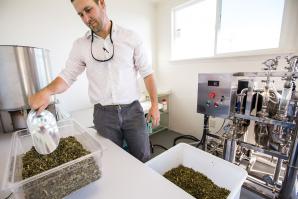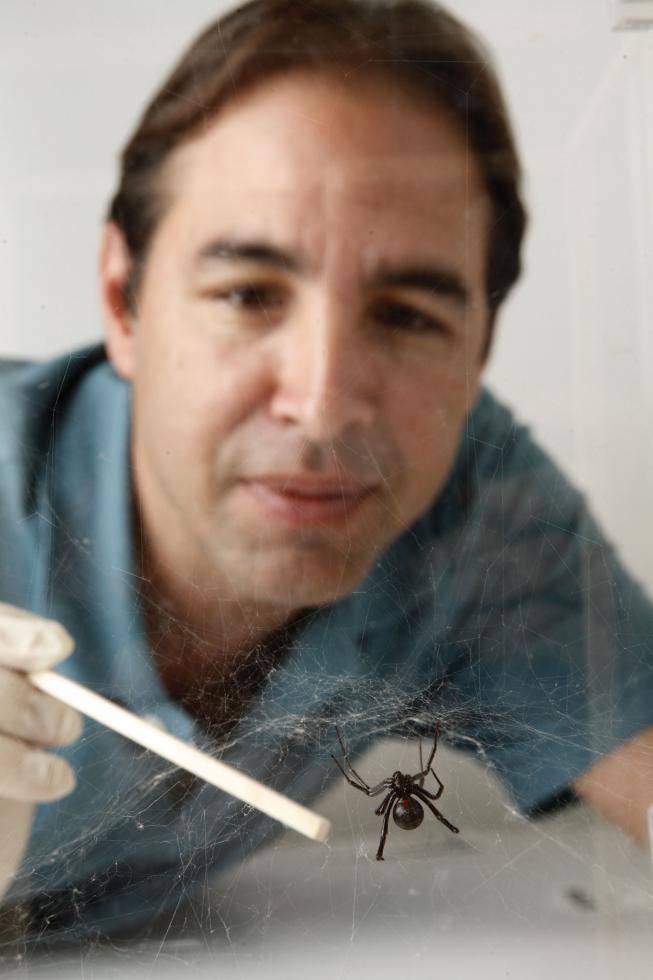The black widows caged in professor Craig Vierra’s laboratory evoke the macabre. But here, in the Department of Biological Sciences at Stockton’s University of the Pacific, these crawlers are the story’s heroines.
Their strong, flexible silk may lead to significant consumer health and safety benefits. Dr. Vierra’s research into the synthetic replication of natural silk is dedicated to that goal. His student assistants are happy to be part of the quest that has put the professor they call Spiderman at the precipice of a breakthrough.
Vierra and his team are rated among the top researchers in the United States for their efforts in documenting the chemistry of spider silk and the mechanisms by which it is produced. Super-tough threads could be used to improve the safety of air bags, seat belts and tires, promote medical advances in wound sutures and replacement tissues, and boost the quality of body armor for police and military personnel.
“There’s a host of material uses for spider silk that could have a wide business impact, including the idea of threads capable of transporting energy,” Vierra says. “This is on the horizon.”
Consider the use of spider threads in football helmets: The idea is to absorb and dissipate kinetic energy, softening head blows and reducing the incidence of traumatic brain injury. The next generation of helmet technology is one of many possibilities Vierra envisions.
“Craig has built this project from the ground up, developing a lot of tools and amassing a lot of knowledge,” says UOP biology professor Geoff Lin-Cereghino. “It’s impressive he’s made so much progress because he had to teach himself everything and train students, enabling them to master a lot of challenging laboratory techniques.”
Former student Kristin Kohler agrees. A post-doctoral assistant in the department, her choice of a science career was shaped by Vierra’s patient dedication.
“The way he goes about his work is so enthusiastic and intelligent that it makes you want to emulate him,” Kohler says. “He gets you motivated and he encourages you.”
“The way he goes about his work is so enthusiastic and intelligent that it makes you want to emulate him.”
Kristin Kohler, post-doctoral assistant, University of the Pacific
Vierra’s work at the forefront of black widow research has earned him $800,000 in grants from The National Science Foundation. He’s continuing to investigate the working methods of the black widow, the molecular mechanics of its silk and the secrets of its personality.
“Black widows have to be able to keep spinning or they will die,” Vierra says, adding that the little workaholics are as inventive as they are prolific. “They produce not one type of silk but seven, which they use for various purposes including construction, protection, mobility and capturing prey.”
While black widows have earned a sinister reputation for being small, quick, deadly and cannibalistic, they pose little threat to humans, Vierra says. Although their bite can be painful, fatalities are rare; they tend not to be aggressive with humans, “unless stepped on.”
One of nature’s most efficient engineers, the black widow carries with it a factory — spinning, cutting and dispensing silk as needed. The high-tensile strength of the silk is five times that of steel, yet light and elastic. The challenge for scientists is finding a method to mass-produce synthetic silk that mimics the strength, elasticity and durability of black widow silk. To that end, scientists must understand how silk proteins are assembled and determine the molecular mechanisms that govern them.
“It’s imperative that scientists persist in their work and create innovative techniques to investigate the potential for synthetic silk,” Vierra says. “If successful, this technology could revolutionize the field of engineering, medicine and nanotechnology. It’s nice to know that what you’re working on could have results in the real world and that it can actually help people. The practical applications and benefits to society are very exciting.”
Vierra’s multidisciplinary approach introduces students to biochemistry, engineering and molecular and organic biology. Students collect spiders in the wild and dissect them in the lab, study silk-producing glands and research silk fibers to ascertain the identities of the proteins found in the threads, work on the artificial production of the proteins and spin the fibers.
It’s a tedious process with a grand prize in view. But Vierra’s modeling of scientific inquiry and ingenuity may be the greatest lesson of all for students.
“The key to Craig’s success is his creativity and novel perspective on problems,” Lin-Cereghino says. “He can create the different technologies needed to achieve his vision of next and take him where he wants to go in his science.”
Recommended For You

Economic Regeneration
Can stem cells grow the region’s bottom line?
A broken leg used to be a death sentence for a horse. Now, the University of California veterinary teaching hospital in Davis is using stem cells to help the horses heal quickly.

Sugar & Splice
The Capital Region offers everything nice for ag-bio companies like Stevia First
A Capital Region startup is striving to be among the first in the nation to produce the zero-calorie, natural sweetener stevia on an industrial scale. An agricultural biotech company, Yuba City-based Stevia First is bolstering its chances of success by actively collaborating with experts in the field, drawing on the area’s robust talent pool of farmers, agronomists, agricultural innovators and biotech experts to develop a product that’s superior in both taste and cost compared to its foreign competitors.



